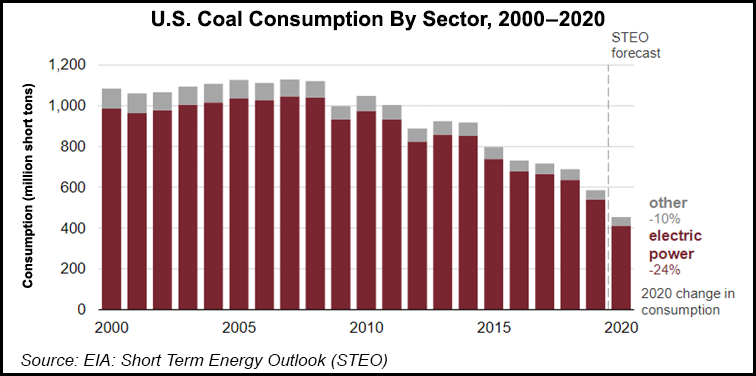NGI All News Access | Infrastructure
Coal Emissions to Lead Historic Decrease in Expected CO2 Emissions in 2020, Says EIA
The U.S. Energy Information Administration (EIA) expects energy-related carbon dioxide (CO2) emissions to decrease 11% this year, which could represent the largest percentage drop and absolute drop since 1949, the earliest year that EIA began tracking data.

While the EIA had expected a drop in CO2 emissions to follow the downward trend since peak emissions in 2007, in light of coronavirus, much of the drop may be the aftermath of travel restrictions. Petroleum product demand declined in mid-March, and by April, reached its lowest levels in decades, EIA said.
Petroleum, the largest single source of energy-related CO2 emissions, is predicted to be down in consumption by 11% in 2020. The ensuing CO2 emissions are predicted by the EIA to decrease 12%.
The second largest energy-related CO2 emitting source, natural gas, amounted to 33% of total 2019 emissions. Both natural gas consumption and emissions are expected to decline 4% from 2019 levels, which were 7% higher than 2018, or an average of 31 Bcf/d.
The electric power sector, the largest consumer of natural gas, may see a 5% decrease in power generation, though due to low costs of natural gas, consumption of the fuel may decline only 1% in 2020.
As for the commercial sphere, natural gas consumption may decline by 7% due to “the closing or reduced operation of many nonessential businesses, combined with generally warmer weather in 2020,” said the EIA.
In 2019, more natural gas and less coal, coupled with the expansion of renewables and higher nuclear generation, led to a steady decline in CO2 levels as the world’s economy grew. Last year, coal CO2 emissions amounted to 21% of total emissions. This year, coal emissions may drop 23%, to 832 million metric tons, EIA said.
More than 90% of coal consumption in the United States was attributed to the electric power sector in 2019. The EIA said it “expects coal to continue to lose market share to natural gas and renewables in the power sector in 2020.”
The EIA forecasts that 2021 may see CO2 emissions rise by 5% year/year as businesses and industries resume normal operations.
© 2024 Natural Gas Intelligence. All rights reserved.
ISSN © 1532-1231 | ISSN © 2577-9877 |
